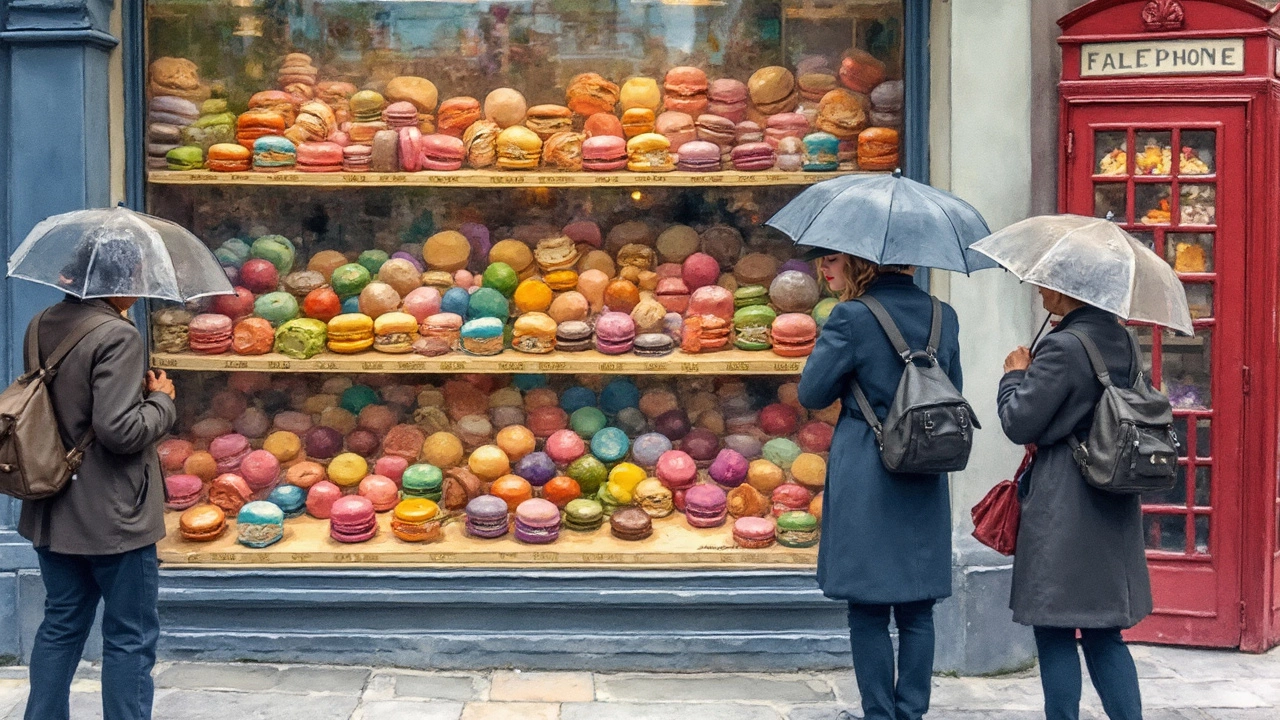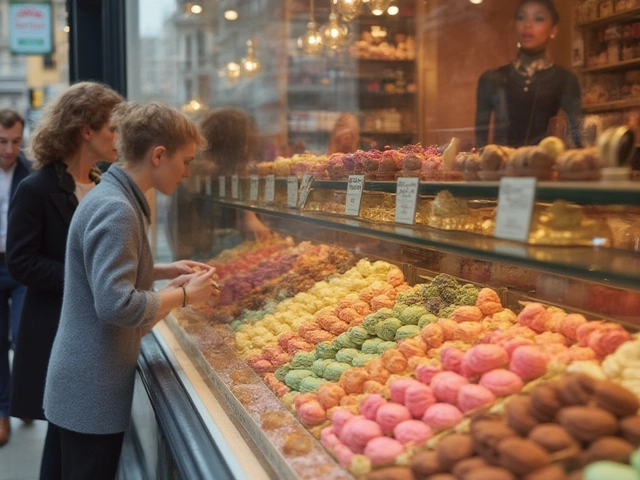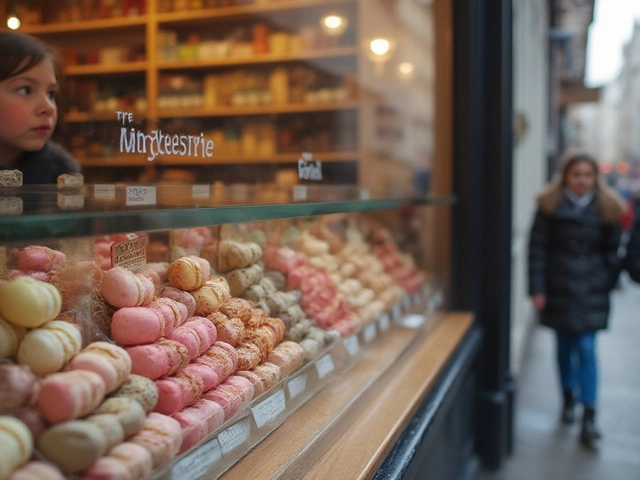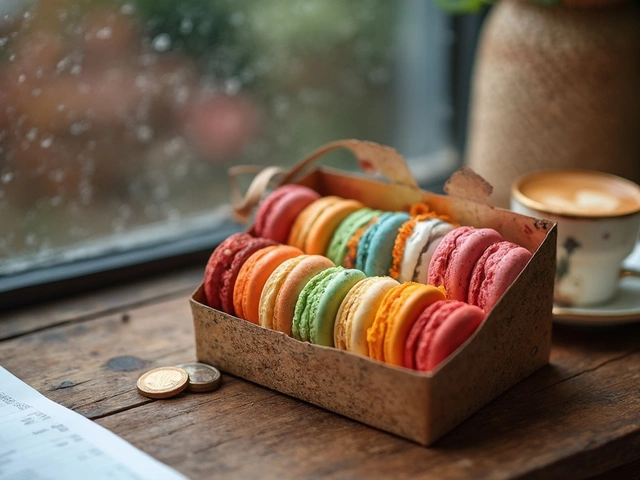
If you've ever looked at a single macaron in a bakery and balked at the price tag, you're not alone. These dainty French cookies manage to be both irresistible and surprisingly expensive. There's a reason you can buy a whole loaf of bread for less than two macarons. But what goes into that price?
Each macaron is made by hand, with almond flour, egg whites, and sugar—ingredients that aren't exactly cheap these days. Plus, getting that perfect crunchy shell and chewy center is an art. Mess up a little part of the process and your batch might end up in the trash. That drives the price up, and so does the fact that so many people see them as a 'luxury dessert.'
So when you're wondering if it's worth paying a few dollars for a single bite-sized treat, there's a lot more happening behind the scenes than most people realize. In this article, you'll see what really affects macaron prices, how to shop smarter, and some clever ways to get your sugar fix without emptying your wallet.
- Why Are Macarons So Pricey?
- Average Macaron Prices in 2025
- What Impacts the Price?
- Are They Worth It?
- How to Save Money on Macarons
- Tips for Getting the Best Macarons
Why Are Macarons So Pricey?
People always wonder why macarons cost way more than a regular cookie. The truth is, every macaron price tag reflects how tricky these little desserts are to make and what goes into them. You can't cut corners—everything from the recipe to the baking process is pretty intense.
First, the ingredients are not your everyday pantry staples. Real macarons need blanched almond flour (not cheap), superfine sugar, and fresh egg whites. Vanilla beans, pure fruit purees, or high-quality chocolate for the filling can push the cost up even more. What also matters is freshness—macarons have the best texture and flavor within a couple of days, so you're paying for baked-to-order goods, not something shipped from a factory weeks ago.
Then, there’s the labor. Macaron batter is super sensitive. If you mix even a little too much or too little, you won’t get those perfect feet or that glossy shell. Bakeries usually toss out a lot of batches that don’t meet the mark. Even piping them onto sheets needs a steady hand, and every one is sorted so only the best go into the display case.
Don’t forget about equipment and time. Serious bakeries need powerful mixers, top-notch ovens, and climate-controlled kitchens because macarons are fussy about humidity and temperature. All of this means more expenses for the baker, which ends up in the final price you pay.
You’re also paying for the experience. People want their macarons to look Instagram-worthy. This means custom flavors, beautiful colors, and careful packaging. Packaging can be almost as fancy as the treat itself, especially if you’re buying a gift box.
Bottom line: you’re not just buying a sweet bite, you’re buying skill, premium ingredients, and the promise that each macaron was crafted with extra care. That’s why the price tag seems so high compared to average cookies or pastries.
Average Macaron Prices in 2025
Macarons have always had a reputation for being a bit of a splurge, and 2025 isn’t any different. Across the U.S., you’ll spot prices ranging from $2 to $3.50 for a single macaron at mid-range bakeries. In big cities like New York, Los Angeles, or Miami, you might even see prices stretch to $4 each—especially for trendy flavors or shops with a fancy reputation. In smaller towns or at local markets, you still won’t find them much below $1.75 a piece as of June 2025.
When you buy in bulk, bakeries sometimes offer small discounts, but even then, you’re looking at around $18 to $24 for a box of six, and $36 to $45 for a dozen. That’s still about $3 or $3.50 per treat, which stings when you compare it to a box of donuts or cupcakes. For special seasonal or limited-edition flavors, expect an extra $0.50 to $1 per cookie, depending on demand and ingredients.
If you’re shopping online, popular places like Ladurée or Dana’s Bakery tag their boxes of 12 at about $38 to $42 before shipping. Factor in the cost of packaging to keep everything fresh (no one wants a box of smashed macarons), plus express delivery, and your total might jump by $10-$15.
Younger or more affordable bakeries on Etsy or local Instagram shops might sell smaller macarons at $15 to $18 a dozen, but those are usually bite-sized and sometimes a little less picture-perfect. Price really comes down to quality, size, location, and exclusivity of flavors. Bottom line: the macaron price in 2025 is higher than a few years ago, mostly thanks to rising ingredient costs and the handmade process behind every shell.
What Impacts the Price?
When it comes to macarons, several factors quietly stack up to bump up the price. You're not just buying flour and sugar. There’s a ton going on behind that pastel shell.
First, ingredients matter a lot. Macarons use almond flour, which can cost around three times more than basic wheat flour. That’s not even counting the real vanilla, fruit purees, and sometimes fancy imports like matcha or pistachio paste. Then add in food-safe coloring, and the bill goes up fast.
The technique is another biggie. Most bakeries either hand-make every macaron or use special equipment that’s not cheap. If someone’s hand-piping 500 shells in a morning, that’s skilled labor, not basic kitchen work. The process is so tricky that even pros mess up batches sometimes. As a French chef explained to The Guardian:
“You’re selling a craft, not just a cake. If you want something perfect every time, you need time and talent.”
Labor costs add up quickly, especially if the shop only trusts highly trained staff with their macarons. Plus, remember all the failed test batches—those hit the shop’s wallet, too.
Packaging also affects the price. Shops love pretty boxes, and those custom tray holders that keep each macaron safe cost real money. If you’ve ever seen a four-pack in a rigid, printed box, know that you paid for the packaging as much as the pastry.
Let’s put some of this into numbers:
| Cost Factor | Typical Share of Retail Price |
|---|---|
| Ingredients (almond flour, flavorings, fillings) | 30% |
| Labor (hand piping, baking, assembly) | 35% |
| Packaging | 15% |
| Overhead (rent, electricity, marketing) | 15% |
| Profit | 5% |
One last point: location plays a part in what you pay. Big city bakeries pay more for rent and staff, so their macarons might be pricier than a small-town shop.
So if you’re ever wondering about those $3 macarons, you’re really paying for more than a macaron price. You’re getting high-cost ingredients, skill, precision, and that little taste of something special that’s hard to find anywhere else.

Are They Worth It?
So, everyone's asking: is one little macaron really worth the price? These treats have a reputation for being pricey, but there's a good reason for it.
First off, making a proper macaron isn't like baking chocolate chip cookies. There's a real science to it. Temperature matters. Humidity totally changes the game. Even professionals toss out full trays that look off—no one wants a lopsided shell when people expect perfection. Some bakeries say their fail rate is up to 30%, which adds up in lost time and supplies.
There's also the ingredient cost. Good macarons use almond flour, which in 2025 is around $9–$12 per pound in the US—a lot pricier than your basic flour. Then add in real flavors (think pistachio paste or freeze-dried raspberries), which aren’t exactly budget buys. And don’t forget the labor: piping, drying, baking, cooling, filling, and pairing each macaron by hand. There’s no way to really speed up the process if you want them to look and taste right.
| Why Macarons Cost More | Cookies (Per Piece) | Macarons (Per Piece) |
|---|---|---|
| Main Ingredient | Wheat flour | Almond flour |
| Avg. Cost (Bakery, 2025) | $0.80 | $2.50 |
| Labor Intensity | Low | High |
| Failure Rate | Rare | Up to 30% |
But do they actually deliver? A good macaron hits you with a unique texture—crispy outside, chewy inside—and flavors you don't get anywhere else. You’re paying for the experience, the ingredients, and yes, a little bit for the Instagram moment. They make birthdays, weddings, and treat-yourself moments feel extra special.
If you’re looking for a cheap snack, macarons probably won’t top your list. But for something that feels a bit fancy or if you want to try something new, they usually earn their spot in the splurge category. Just be picky—buy from a place that does them right, and you’ll get what you pay for.
How to Save Money on Macarons
Macarons aren’t just a little splurge—they really add up if you're buying them often. Luckily, there are a bunch of ways to get your fix without blowing your budget.
- Buy in Bulk: Almost every bakery offers a discount if you buy a box instead of singles. A single macaron might be $2.50, but a 6-pack could drop the price to $2 each. Check for deals on a dozen, especially around holidays.
- Shop Late in the Day: Some bakeries mark down prices in the last hour or two before closing. Macarons still taste great the next day, so it’s a win-win.
- Skip Fancy Packaging: Extra packaging means higher costs. Some places charge $3 or more just for a gift box. Ask for simple packaging to cut the price.
- Go Local, Not Designer: Smaller shops or farmers’ markets often have better prices than the big French chains. Same flavor, less markup.
- Watch for Loyalty Discounts: Lots of shops let you sign up for points or mailing lists. It’s an easy way to score discounts or freebies after a few visits.
- Make Your Own: Sounds intimidating, but home kits have gotten super popular (and much easier). You’ll save a bunch per cookie, and you can customize flavors for less than half the bakery price.
Here’s how prices break down for different buying habits:
| Buying Option | Average Price per Macaron |
|---|---|
| Single Retail Macaron | $2.50 |
| 6-Pack Box | $2.00 |
| Dozen Box (Bakeries) | $1.85 |
| Farmers’ Market | $1.50 |
| DIY (Homemade Kits, per cookie) | $0.80 |
Small changes make a big difference. If you buy just one dozen macarons monthly, swapping from retail singles to making your own could save you about $20 a month. That’s enough for another treat—or a nicer coffee to go with your macaron price savings.
Tips for Getting the Best Macarons
Scoring good macarons isn’t just luck—it’s about spotting quality and knowing what you want. Nobody wants to drop cash on dry, flavorless cookies or end up with a box of broken shells. Here’s what to look out for and how to make your macaron habit worth the splurge.
- macaron price: Compare the cost per piece if you’re buying a box—sometimes you save more by going for a pack.
- Look for smooth, shiny tops with ‘feet’. That bumpy edge at the base isn’t a flaw—it’s the secret to a well-made macaron.
- The best macarons feel light but don’t fall apart. Press gently; the shell should be crisp, but not so hard it crumbles.
- Flavor should match the color. Lemon should taste like real zest, chocolate should be rich, strawberries should taste like actual fruit, not just sugar.
- Macarons are freshest within two to four days of being made. If you can, ask when they were baked.
Planning to bring them home? Humidity is their enemy. They’re best stored in an airtight box in the fridge, then let them warm up for about 15 minutes at room temp before eating—that’s when the texture hits its sweet spot.
If you want to try new spots, don’t be shy about reading online reviews or checking photos from real buyers. Shops with consistent four-star reviews or higher rarely let people down.
| Brand/Bakery | Avg. Price per Macaron (USD) | Freshness (Days Best Eaten) | Popular Flavors |
|---|---|---|---|
| Ladurée (NYC) | $3.20 | 2-3 | Pistachio, Vanilla, Rose |
| Macaron by Patisse (Houston) | $2.50 | 2-4 | Salted Caramel, Raspberry, Dark Chocolate |
| Local Artisan Bakeries | $1.95-$2.75 | 1-3 | Rotating Seasonal |
If you see a macaron that’s neon-bright, be cautious—too many artificial colors usually means less attention to authentic flavors. Last tip: sometimes it’s cheaper during off-peak hours or close to closing, when bakeries bundle deals to clear inventory. Don’t be afraid to ask for the day’s best offer.












Write a comment